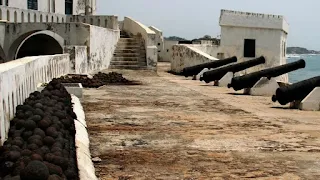Importance of Ghana Slave Castles
The three largest slave castles in Ghana were Cape Coast Slave Castle, Fort St. Jago and Elmina Castle.
Ghana was a major hub for the transatlantic slave trade for centuries. Ghana slave castles are an important reminder of the horrors of slavery and the importance of never forgetting the past.
Between 1482 and 1786 in Ghana, European-style coastal forts and slave castles were built to house millions of newly captured African slaves, gold, wood, and textiles arriving in North America to work plantations in English colonies.

|
| Cape Coast Slave Castle in Ghana |
Because of the Atlantic slave trade and the profound effect on the history of West Africa numerous forts were built perched on Ghana's Atlantic Coast. Ghana was called the Gold Coast at the time of the slave trade, the importation of slaves into the United States was outlawed in 1807. The Castles and Forts of Ghana shaped not only Ghana’s history but that of the world over four centuries as the focus of first the gold trade and then the slave trade.
The Cape Coast Slave Castle, also known as the Cape Coast Castle or the Castle of St. George, is a historical site located in Cape Coast, Ghana. It was originally built by the Portuguese in the late 15th century as a trading post, but later became one of the most important slave-holding and slave-trading centers on the West African coast.
For more than 200 years, millions of African men, women, and children were captured, imprisoned, and sold into slavery through the Cape Coast Castle. They were held in cramped dungeons and shipped to the Americas, Europe, and other parts of the world to work on plantations and in other industries.
Today, the Cape Coast Castle is a UNESCO World Heritage site and serves as a museum and memorial to the atrocities of the transatlantic slave trade. Visitors can tour the castle and learn about the history of the slave trade, view the dungeons where enslaved Africans were held, and pay their respects at the Door of No Return, where enslaved Africans were forced onto ships bound for the Americas.
The castle is an important reminder of the horrors of slavery and the importance of never forgetting the past. Cape Coast Castle was built by the Portuguese in the 15th century, Cape Coast Castle is one of the largest and most well-known slave castles in Ghana. It was a major hub for the transatlantic slave trade for more than 200 years.
Elmina Castle, also known as St. George's Castle, is another significant slave castle in Ghana. It was constructed by the Portuguese in the late 15th century and was the first European trading post in West Africa. Fort St. Jago is a fortress located in Elmina, Ghana, that was built by the Portuguese in the 16th century. It was used as a military base and a trading post, but it also served as a holding facility for enslaved Africans.
Fort Metal Cross is a fort located in Dixcove, Ghana, that was built by the Dutch in the late 17th century. It was used to protect Dutch trading interests in the area, but it was also used to hold enslaved Africans. Visiting these slave castles can be a deeply emotional and educational experience, providing visitors with a glimpse into the horrific history of the transatlantic slave trade and its lasting impact on the world.
Many rulers of West African empires, such as the Ashanti kingdom, whose descendants still live in this part of modern-day Ghana, also profited, selling captured slaves in exchange for guns, jewelry, cloth, alcohol and other manufactured goods.
Slave forts on the Atlantic like the Cape Coast and Elmina castles were the last place captured African slaves would ever see in their homeland. From castles such as the three largest, Cape Coast Castle, Fort St. Jago and Elmina Castle where European authorities lived in comfort right above the dungeons that held the slaves, the captured Africans walked through the Door of No Return onto the ships that would take them to America.
Around 40 slave castles were built in Ghana, the three largest slave castles were Cape Coast Castle, Fort St. Jago and Elmina Castle.
| Cape Coast Castle | Elmina Castle |
Fort St. Jago |
|---|---|---|
| Built by Sweden in 1653 | Built by the Portuguese in 1482 | Built by the Portuguese |
| Castle dungeon a place of death | 30,000 slaves passed through each year | Military base built onsite |
Ghana has been inhabited for at least several thousand years. The castles and forts were built and occupied at different times by slave traders from Portugal, Spain, Denmark, Sweden, Holland, Germany and Britain. Elmina Castle, built in 1482, is one of the oldest European buildings outside Europe, and the historic town of Elmina is believed to be the location of the first point of contact between Europeans and sub-Saharan Africans.
"Slavery is not something from the past, it still has tragic consequences today. We need to continue talking about the heritage and acknowledgment of the important contributions of enslaved people to our modern world. In parallel, racism and discrimination, which are still poisoning our world today, need to be eradicated." Gabriela Ramos UNESCO Assistant Director-General for Social and Human Sciences
More links to articles you will find thought provoking.
-
That African Fabric You're Wearing Isn’t African

-
About neck elongation rings

-
Lighthouses of Egypt and Morocco

-
Mental Illness in Africa Taboos

-
Kente cloth inspired by a spiders web






